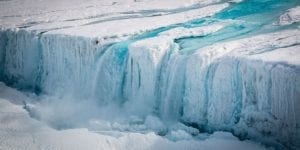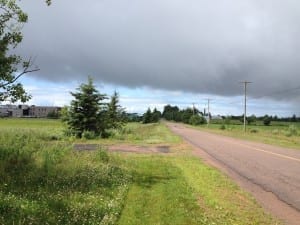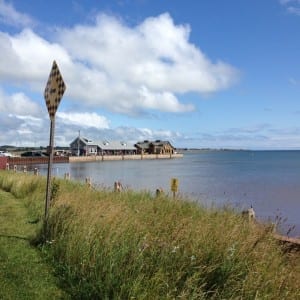Coastal erosion due to sea level rise in Prince Edward Island is highlighted at these links
*
Updates
A Nov. 18, 2016 Water Canada article is entitled: “Evaluating Long-Term Performance From Low Impact Development Practices.”
A July 12, 2017 CBC article is entitled: Don’t drain the swamp: report says wetlands help avert flood damage: Study says leaving wetlands in their natural state can help protect communities from severe flooding.”
As well, I recently learned about a resource entitled: Time and a Place: An Environmental History of Prince Edward Island (2016).
A blurb for the book (which I’ve broken into shorter paragraphs) reads:
With its long and well-documented history, Prince Edward Island makes a compelling case study for thousands of years of human interaction with a specific ecosystem. The pastoral landscapes, red sandstone cliffs, and small fishing villages of Canada’s “garden province” are appealing because they appear timeless, but they are as culturally constructed as they are shaped by the ebb and flow of the tides. Bringing together experts from a multitude of disciplines, the essays in Time and a Place explore the island’s marine and terrestrial environment from its prehistory to its recent past.
Beginning with PEI’s history as a blank slate – a land scraped by ice and then surrounded by rising seas – this mosaic of essays documents the arrival of flora, fauna, and humans, and the different ways these inhabitants have lived in this place over time. The collection offers policy insights for the province while also informing broader questions about the value of islands and other geographically bounded spaces for the study of environmental history and the crafting of global sustainability.
Putting PEI at the forefront of Canadian environmental history, Time and a Place is a remarkable accomplishment that will be eagerly received and read by historians, geographers, scholars of Canadian and island studies, and environmentalists.
[End]
A June 13, 2019 Toronto Star article is entitled: “The siege of PEI: ‘Everything is going against us,’ says Adam French, the climate sciences of Prince Edward Island.”
An excerpt reads:
“‘Bit by bit, Prince Edward Island, made of sandstone and sand, is slowly washing into the sea and “everybody knows it,’ Fenech says.”
[End]
The article quotes Stephanie Arnold, a PhD student at the UPEI Climate Lab, who notes that despite the obvious and immediate effects of flooding, it’s her belief that food security is a larger concern.
*
Recently I’ve checked out some links related to coastal erosion due to sea level rise in Prince Edward Island. For your interest, a selection of the links includes:
http://shipsforcanada.ca/our-stories/understanding-sea-level-rise-and-coastal-erosion
http://www.rcinet.ca/en/2016/12/09/climate-change-and-p-e-i-s-slow-disappearance/
https://www.canadiangeographic.ca/article/adam-fenech-peis-rising-sea-levels
http://www.cbc.ca/news/canada/prince-edward-island/victoria-by-the-sea-shoreline-1.2700789

A 130-metre-wide waterfall drains meltwater from the Nansen Ice Shelf into the ocean.
Image: Stuart Rankin via Flickr. The image is from the April 22, 2017 Climate News Network article mentioned at the page you are now reading.
Lidar imaging technology
Some of the links mention lidar technology, which I’ve also discussed at previous posts in other contexts:
I have updated an earlier post about the use of the lidar device in archaeological research
Updates
A Jan. 26, 2017 Yale Environment 360 article is entitled: “How the World Passed a Carbon Threshold and Why It Matters.”
An April 15, 2017 American Geophysical Union article is entitled: “How the Disappearing Arctic Ice is Already Changing Your Weather.”
An April 22, 2017 Climate News Network article is entitled: “Surface of Antarctica swimming with water.”
An April 24, 2017 CBC article is entitled: “Arctic climate warming higher and faster than expected: Open water in Arctic Ocean affecting weather patterns around world.”
An April 24, 2017 ThinkProgress.org article is entitled: “Climate change poses ‘nightmare scenario’ for Florida coast, Bloomberg warns: America’s trillion-dollar coastal property bubble could burst ‘before the sea consumes a single house.’ Here’s why.”
An April 28, 2017 Scientific American article is entitled: “Major Report Prompts Warnings That the Arctic Is Unravelling: The polar region is warming more than twice as fast as the rest of the planet.”
A study regarding a previous sea-level rise is entitled:
The Remembered Land: Surviving Sea-level Rise after the Last Ice Age (2015)
A May 1, 2017 Observer article is entitled: “More Than 90 Scientists Release Report That Arctic Is ‘Unraveling’: The Arctic has been warming twice as fast as the rest of the planet for the past 50 years.”
Updates: Flooding elsewhere
A May 6, 2017 CBC article is entitled: “How to cope when your stress levels rise with the floodwaters: A flood is one of the most stressful disasters to deal with, because ‘it goes on for a long time,’ expert says.”
A May 6, 2017 CBC article is entitled: “Why your insurance likely won’t protect you if your basement floods: Most policies don’t include ‘overland flood insurance’ — even if they do, there are limits.”
A May 6, 2017 CBC article is entitled: “Quebec enlists Canadian Forces in fight against rising floodwaters: Record precipitation levels threaten to trigger widespread flooding in Ontario, Quebec and the Maritimes.”
A May 7, 2017 Washingtonian article is entitled: “The Billionaire and the Flood: How a Tragedy Transformed the Greenbrier Resort and the Blue-Collar Town that Depended on It: One year ago this June, a historic flood lashed West Virginia, killing 23 people and crumpling homes. It also exposed the complicated relationship between a resort that draws Washington’s rich and powerful and the blue-collar town that houses the hotel’s staff. What happened afterward surprised everyone.”
A May 17, 2017 Metro Toronto article is entitled: “Toronto floods give rise to calls for better infrastructure: Extreme weather events like the Island flood will happen more frequently, say experts.”
Also of interest:
TRCA Flood Monitoring and Real Time Gauging: Handy online resource
A May 18, 2017 three-part New York Times article about climate change and the Antarctic is entitled: “Looming Floods, Threatened Cities.”
A May 18, 2017 Climate Central article is entitled: “Sharp Rise in Flooding Ahead for World’s Poorest.”



I’m surprised only that Irving is funding research on this. of course, he’s forced to.
But Irving has been a leading climate change denier. They’re a most unattractive family.
What I’ve noticed in those waters is the tremendous drop in sea life. Forty years ago, walking on the sandbars, I would see hundreds of crabs. For some years now, I’ve seen none – not even dead shells.
There were also uncountable thousands of tiny fish – about aquarium size. I haven’t seen one of those, either, for years. At best, I find a very occasional clam or snail. That’s it.
graeme
Climate change denial makes sense only for those who focus exclusively on short-term profits. In the long run, ignoring climate change is bad business. Exclusivity of focus, as with exclusivity at a wide range of levels of human experience, in the end exacts a huge cost.
The April 23 2017 issue of The New York Times Magazine is devoted to climate change. It makes for interesting reading. Among other things, it talks about insurance issues related to disappearing shorelines.
A small note of interest: If you like to buy the Sunday New York Times on occasion, it’s good to keep in mind that the price varies depending on where you buy it. The range I’ve encountered is between about $8.50 and $10.50.
When you buy the weekly New York Times, there can also be a slight shift in prices, depending on where you buy. When I buy the New York Times, I usually choose a 7-11 on Lake Shore Blvd. West near the Humber College Fitness Centre. At the 7-11, the prices are at the lower end of the scale.
A Nov. 26, 2021 CBC article is entitled: “Up to 10% of homes could now be ‘uninsurable’ because of flood risk. Yours may be one of them: Lack of insurance awareness, vague real estate rules and incomplete flood maps leave Canadians at risk.”
An excerpt reads:
Despite the stark warnings about the impact of climate change and the threat of flooding, the issue isn’t always top of mind. A 2020 survey by Partners for Action, a climate resiliency network based at the University of Waterloo, found only six per cent of Canadians living in designated flood-risk areas knew they lived in such an area, and only a quarter said their insurance company had discussed flood coverage options with them.
A Nov. 26, 2021 Reuters article is entitled: “With sponges and petitions, climate activists take on insurers.”
An excerpt reads:
A prominent activist is calling on insurers like Swiss Re to explore suing major oil companies for climate-related damages, the latest volley in a years-long campaign that pits environmentalists against the insurance industry.